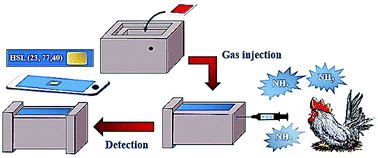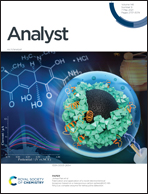A rapid and highly sensitive paper-based colorimetric device for the on-site screening of ammonia gas†
Abstract
A rapid and highly sensitive paper-based colorimetric device for the on-site detection of ammonia (NH3) gas is presented in this study. The detection principle of this device is based upon a change of color from red to yellow on a paper that has been immobilized with a pH indicator, i.e., methyl orange (pKa = 3.4), in the presence of NH3 gas. The color signal of the device can be measured through the hue channel of an HSL system via the application of a smartphone. This device can detect the amount of NH3 gas within 3 min. The linear relationship between the NH3 gas concentration and the hue signal was found to be in the range from 6.0 to 54.0 ppbv with R2 = 0.9971, and the limit of detection was found to be 2.0 ppbv. In addition, this device showed remarkably high selectivity to NH3 gas amongst the other common volatile organic compounds and general gases that are present in environmental air without the assistance of any membrane material. Furthermore, we demonstrated the applicability of this device for the detection of total NH3 gas at a chicken farm and in a laboratory, with relative standard deviations of 6.2% and 5.4%, respectively. The developed NH3 gas device in the study is easy to operate and cost-effective, with the reduction of a large consumption of chemical reagents; also, its signals can be measured simply and then recorded through a smartphone. It is suitable for the application of routine on-site detection of NH3 gas, especially concerning regions which have limited resources.



 Please wait while we load your content...
Please wait while we load your content...